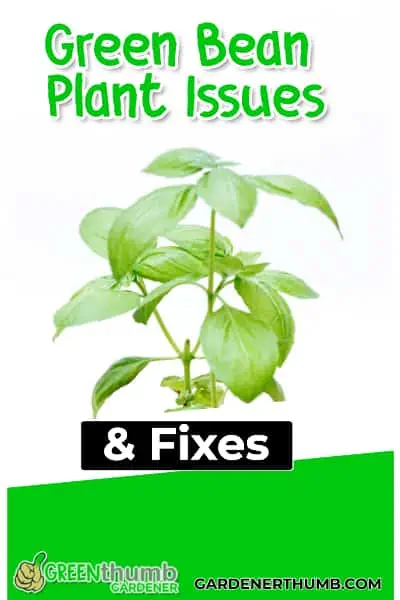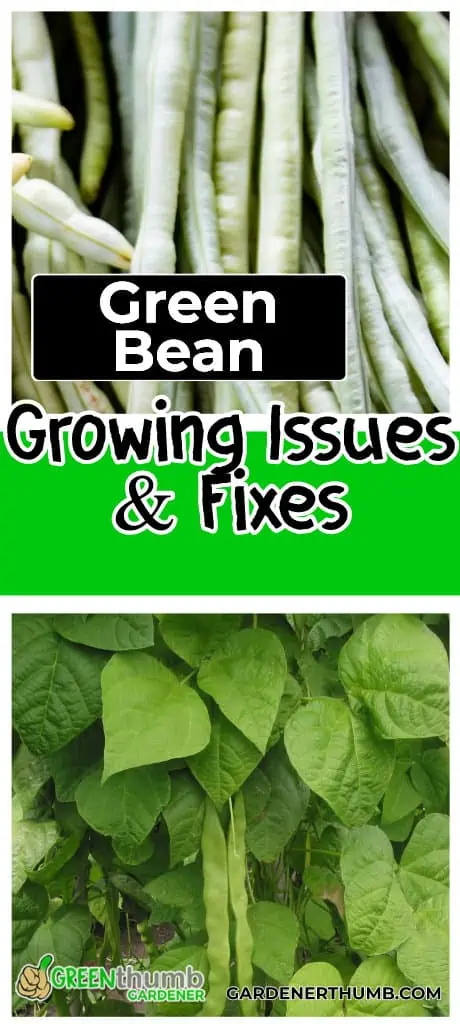Why Your Green Bean Leaves Are Turning Yellow
In gardens across the United States, beans are a dependable and easy-to-cultivate crop. They welcome the arrival of summer. They thrive in full sun, with well-drained soil and warm weather.
Beans, which can produce pods all summer, are among the first vegetables harvests. However, green beans are susceptible to developing yellow leaves if they are not properly cared for.
Are you ready to find out why are your green bean leaves turning yellow and how to fix it?
Green thumb Gardener occasionally links to product and/or services offered by vendors to assist you with all your gardening needs. Some of these may be affiliate links, meaning we earn a small commission if items are purchased.
Want to Download a Garden Hack Guide for FREE

Enter your email below and we will send you a guide to help you SAVE money in your garden.
Reasons Why Your Green Bean Leaves Are Turning Yellow
Garden beans, despite their ease of cultivation and significant yields, are prone to yellowing leaves. The appearance of yellow leaves on pole beans may be an indication of more significant problems.
There are a number of reasons for the yellowing of the leaves of bean plants. Some of these include insufficient hydration, poor soil conditions, viral infections, or fungal diseases.
Why are your green bean leaves yellowing and what can be done about it?
Let’s look at some possible causes on infected green bean plant’s leaves:
1. Insufficient Sunlight
Sunlight deficiency is another common cause for a green bean plant to become yellow. Green beans require 6 to 8 hours of direct sunlight daily to reach their full potential as a warm-season crop.
The process of photosynthesis depends on the amount of sunshine your plant receives, so be sure to provide it with that.
Leaves may be unable to synthesize chlorophyll required for photosynthesis if plants do not receive enough sunshine. Plants produce green pigment chlorophyll to absorb sunlight.
As a result of a lack of chlorophyll in the plant’s leaves, it begins to yellow and eventually dies.

On the other hand, planting locations that receive sufficient sunlight will produce new green growth.
Solution To Fix
When organizing your garden, you should ensure that the location you choose for your beans has enough direct sunlight while offering an appropriate amount of shade.
Seedlings should be moved if they receive fewer than six to eight hours of direct sunlight each day while growing.
However, do not pull out your plants if they have already been planted and are well-established in their locations.
They might not make it through the transplanting process.
2. Improper Watering
Water is the means through which nutrients are transported to the most remote parts of your plant’s body. However, your plant might become discolored due to bad watering habits such as under or over-watering.
Yellow spots appear, and the entire leaf becomes yellow after a while.
Over-watering is harmful since it suffocates the plant, depriving it of essential nutrients. In addition, plants can be suffocated by excessive watering. Root rot can result from excessive soil moisture causing yellow leaves in beans.
On the other hand, insufficient watering prevents the absorption of nutrients. Without these nutrients, the plant will wither and die prematurely.
Therefore, you must water your plants with 1 – 2 inches a week.
Avoid overhead watering and apply the water directly to the soil to guarantee that your plants receive the required nutrients. Because clay-based soils hold moisture better than sandy soils, they don’t need as much watering.
Solution To Fix
There’s no easy way to know if you’re over or under-watering your plant.
However, you can use your fingers or stick to probe the soil around 2–3 inches deep to see if your green bean plants need watering or not.
Do not water if the dirt adheres to the stick or your finger. Water your plants if the soil seems dry.
3. Bad Soil Conditions
Bad soil conditions can cause yellowing. You must use well-draining soil to keep the roots from rotting. However, it’s essential to keep the soil moist to the touch but not soggy.
Green beans thrive on sandy and silty loam soils. However, they can thrive in a variety of soil types, with except soils rich in clay. They want neither acidic nor alkaline soil, preferably between the 5.5 and 7.0 pH range.
The soil temperature should also be at least 50 degrees Fahrenheit.
Solution To Fix
Use a soil testing kit to measure the soil’s pH. A liming agent, such as agricultural limestone, can raise the soil’s alkalinity.
Use a soil acidifier to lower alkalinity if your pH exceeds 7.0. Using organic mulch can help keep the soil warm and prevent it from becoming overly dry.
On the other hand, sulfur can be added to the soil if the pH is too high. If your green bean plant is growing in the neutral soil it prefers, you should expect to see new growth of green leaves soon.
Agricultural sand can be added to help drain clayey soil. To improve water retention, add organic matter to soil that is too sandy. In addition, you can enhance the quality of the soil by adding organic matter or compost.
4. Lack of Nutrition
Green beans, like other plants, require adequate nutrient levels to thrive and produce a healthy harvest. They are light feeders and require less fertilizers. However, you must be aware of the warning signs of nutrient deficiency.
Yellow leaves with green veins signal nutrient inadequacy. Yellowing and brown patches on older leaves are signs of manganese deficiency in green bean plants.
On the other hand, a nitrogen deficit may also cause the yellowing of bean leaves.
Practice crop rotation that includes nitrogen-fixing crops. In addition, you can also use high-nitrogen commercial fertilizers.
However, too much fertilizer might burn your plants, so use it only when needed. In addition, you should try to provide it with a more balanced nutrition regimen.
Solution To Fix
A nutrient testing kit can identify whether or not a nutrient is lacking in the soil. After receiving the results, you can purchase soil-specific fertilizer to fix the issue.
After correcting the nutrients in the soil, the plant should begin to restore its green hue. Improve drainage and soil nutrition by amending the soil with aged compost or organic waste.
Your green beans will benefit significantly from the addition of compost.
5. Damage to the Root System
The color of your plant can be significantly changed by root damage. As a result, the roots will be unable to supply the plant with the nutrients and water it needs to thrive. Compacted roots may be to blame for yellowing green beans if you have grown them in a container.
Plants that are cultivated in containers that are too small can have their roots suffocate, causing the leaves to turn yellow and fall off.
Green beans should be replanted in a larger container if possible. Your plant’s health depends on proper drainage, which can allow the roots to develop more freely and prevent root rot.
Solution To Fix
Plant your green beans directly in the ground to have plenty of air circulation around their roots. The roots of your green beans should always be inspected before replanting them.
It’s easy to spot excellent roots because of their delicate yellowish-white color. However, rot may have taken hold if there is a strong odor and the roots appear darker.
When this happens, it is best to remove the plant and start over from scratch if possible.
6. Viral Illnesses
Green beans are highly susceptible to mosaic viruses. They’re caused by bean aphids, which spread the disease from plant to plant.
The bean common mosaic virus (BCMV) and the bean yellow mosaic virus (BYMV) are two distinct bean mosaic viruses that affect green beans and other bean vegetable crops.
Given the prevalence of these two illnesses, thoroughly examining your plants will be beneficial. The most common viruses cause the plant to grow slowly and ultimately kill your beloved bean plants.
Fortunately, due to the recent development of disease-resistant green bean types, spreading the virus is often less of an issue.
Solution To Fix
Unfortunately, there is no cure for mosaic virus problems, which are usually caused by infected bean plant seeds.
So to keep the disease from spreading to your other green bean crops, you’ll have to destroy the contaminated plants or possibly the entire bean crop.

Since aphids can spread the virus, you can keep them at bay with insecticide soap or other pesticides. As a general rule, you should only buy seeds from reliable sources.
Also, make sure that they are disease-resistant so you can break the cycle of disease.
7. Overcrowding
Unless the green bean plants are thinned out at the appropriate time, they will not receive adequate sunlight, nutrients, or air circulation. Overcrowding is often caused by over-seeding.
In this method, you plant seeds and then thin them out when they reach the right height.
It is essential to get the most out of your garden by employing techniques such as overseeding. However, your garden will become overcrowded if you do not thin your plants.
Beans aren’t known for their ability to withstand being crammed together because this isn’t typical of their environment.
As a result, the leaves of the plant can turn yellow, and the plant’s growth might be stunted.
Solution To Fix
Ensure sufficient space for your plants to expand and develop as they mature. Ensure the gap between plants is no more than 8 to 12 inches.
This will help avoid spreading disease and pests by allowing the air to circulate freely.
8. Pests
Green bean plants are especially susceptible to damage from pests. This is because insects are drawn to green beans in higher numbers than other plants.
Pests such as aphids, for instance, can also cause the leaves on your plant to get wrinkled and develop a yellowish color.
Mexican bean beetle, cutworms, and vegetable leaf miners are also responsible for the yellowing of bean plants.
In addition, the potato leaf hopper, thrips, and two-spotted spider mites are all sap-sucking insects that can potentially cause yellowing and deformation of the plant.
Solution To Fix
Ladybugs and other helpful insects, including wasps, can be a great way to keep pests at bay in your garden. These insects will eat pests in your garden and prevent the growth of pests.
Organic products like neem oil should be used if you need to fix it immediately.
In addition, you can spray a garden hose with insecticidal soap. Aphid colonies and spider mites can be successfully treated using this method.

Further Reading
9. Diseases
Yellowing of the leaves on green plant beans can be caused by various plant diseases, including:
- Alternaria leaf spot
- Bean rust
- Black root rot
- Fusarium root rot
- White mold
- Bacterial blight
- Bacterial brown spot
- Fungal infections
- Halo blight
These diseases can be transmitted from plant to plant. In addition, insects and other critters can also pass some on.
Solution To Fix
Bacterial diseases, such as blight, can be transmitted by water. Keep a safe distance from your plants while they are damp to prevent the spread of pests and disease. It is best to remove the contaminated portion of your plant.
Prevent the spread of disease between each cut by washing your pruners after you cut infected plant debris in a solution of bleach and water.
After removing affected plant tissue, apply fungicide or neem oil to the plant as a whole.
Another thing to note is herbicide injury from trying to treat plants. Be aware and use caution with any herbicide.
Final Thoughts
It is not uncommon for pole beans to have yellow leaves that are unpleasant to look at.
However, the yellowing may be substantially more severe in other cases, and it may considerably impact the crop of beans you are growing.
Therefore, it is essential to take immediate action to prevent the situation from deteriorating further.







